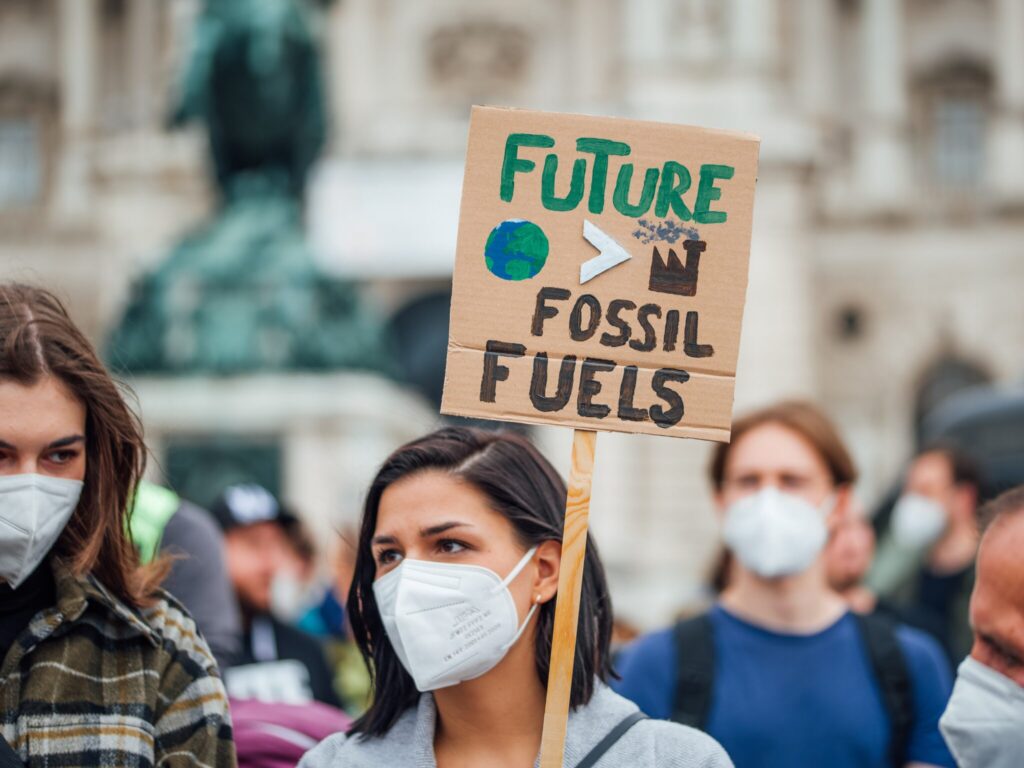9 Mins Read
By one tally, 401(k)-type plans are providing $46.5 billion to Big Oil right now.
By Barbara Grady
People often debate the best things individuals can do to help solve the climate crisis — ditch your combustion engine car for an electric vehicle? Stop eating meat? Go solar? Vote? Though each of these can add up to a big impact, there’s another action that people haven’t paid much attention to until recently: steering money saved in their retirement accounts away from fossil fuels.
U.S. residents are saving more than $7 trillion in 401(k) retirement plans offered by corporate employers, according to the U.S. Government Accountability Office. When similar plans offered by state and local governments and nonprofits are added, Americans have $9.9 trillion in employer-sponsored retirement savings plans.
That’s a hefty amount of financial power. Consider that transitioning the economy to net zero emissions by 2050 — as scientists say is necessary to avoid the very worst, irreversible effects of the climate crisis — will require an investment of $4 trillion a year, according to the International Energy Agency. So putting even just a portion of the money socked away in 401(k)-type retirement savings plans into climate-friendly investments could do a lot of good. Likewise, ridding your 401(k) savings plan of fossil fuels investments might also help the climate. By one tally, retirement savings plans are providing $46.5 billion to Big Oil right now.
That’s the rallying cry behind #RetireBigOil, a virtual march on Wall Street launched in February 2024 by 37 environmental organizations and sustainable investment firms. Organizers calculate that a fifth or more of the market value of oil majors is money invested from 401(k) plans and individual retirement accounts, or IRAs. As environmental activist Bill McKibben posted on X, “More than 25% of ALL money invested in U.S. oil, coal, and gas companies comes from our 401(k) retirement savings.”
If those investments were not available to companies drilling for oil and gas or mining and burning more coal, the effect might be the equivalent of removing 22 tons of carbon a year from the atmosphere, according to FossilFreeFunds, which provides a tool for searching fossil fuel holdings in mutual funds based on data from Morningstar.

That 22 tons a year is more than would be removed by a collective shift to solar or EVs, march organizers say. Of course, getting there would require cooperation from everyone who participates in 401(k)s and it assumes selling those oil stocks and bonds won’t just result in someone else owning them and supporting these companies. The reality is that there are many eager buyers of oil and gas and even coal stocks, especially since their profits have surged since the Russian invasion of Ukraine caused an energy panic. This has stymied efforts at divestment.
Of course, Big Oil stock prices are extremely volatile, just like crude oil prices, and they are vulnerable to steep declines as happened during the early lockdown period of the COVID-19 pandemic. A report by Columbia University’s Center on Global Energy Policy found that oil and gas stocks, while they did well in 2022, underperformed against the S&P index between 2017 and 2022. Likewise, a McKinsey & Co. study found oil and gas returns underperformed over the past 15 years.
As people learned when many high-flying financial stocks tanked during the 2008 financial crisis, selling stocks as they are falling out of favor is a recipe for losing a lot of money. So dumping oil and gas stocks now, at the current elevated levels, may be a smart financial move for 401(k) plans.
But perhaps the bigger problem is that lots of people, probably most, do not even know whether their 401(k) is heavily invested in oil stocks.
“This issue hasn’t gotten more traction because most people, when they hear 401(k), they tune out, it’s boring or they don’t understand,” said Alex Wright-Gladstein, initiator of the #RetireBigOil march, in an interview. Her concern led her to found Sphere, an organization offering information on the fossil fuel content of many company 401(k) plans as well as a fossil-fuel-free index fund. “The focus of our campaign is to make people aware.”
For two weeks in February, more than a thousand people “marched” or posted on social media that they wanted to get oil out of their 401(k)s. Those posts and media stories received millions of impressions, she said.
A host of other organizations have also been raising red flags about retirement plans’ substantial investments in oil and gas.
Financial risks of climate change
Extreme weather disasters intensified by climate change caused 492 deaths and $93 billion in damages in 2023 in the U.S. alone. Worldwide, extreme weather disasters caused $360 billion in damages in 2022. If the mounting toll sours investors on companies whose operations contribute to climate change, investment fortunes could turn quickly.
“The vast majority of the $35 trillion in American retirement assets are invested without consideration of the financial risks posed by climate change,” writes sustainability nonprofit Ceres, my former employer, referencing not only 401(k)s but also public pension funds and IRAs. “From flood and fire risk in the real estate market to transition risk in the energy sector, the life savings of retirement participants need to minimize losses to ensure a secure future for savers.”
As You Sow, a shareholder advocacy group for environmentally and socially responsible investing, says, “When retirement plans offer fund options containing high-carbon fossil fuel bonds, employees are exposed to greater climate risk. As the climate becomes destabilized by climate-related emissions, investors, including employees, are at greater risk of financial losses from extreme weather, stranded assets, systemic risk, and spillover effects.”
New York State Comptroller Thomas DiNapoli, sole trustee of the state employees retirement fund, has gotten out ahead of this risk. He, his department, and his board developed a climate action plan for the $260 billion New York State Common Retirement Fund that gradually reallocates more of the portfolio away from fossil fuels and toward low-carbon investments, climate solutions, and climate-resilient infrastructure investments.
“Climate change is an increasingly urgent risk facing all investors, and I am determined to protect the state’s pension fund by keeping it at the forefront of efforts to mitigate risks to our investments,” DiNapoli said in a recent statement. “This reduces our fund’s exposure to fossil fuels. Consistent with my fiduciary duty to maximize investment returns for the benefit of our members and retirees, these actions should help accomplish the goals of our Climate Action Plan.”

The fix
So why don’t we all just go change out our 401(k) selections to get rid of oil?
It isn’t that easy.
Fewer than 5% of 401(k)-type plans even offer climate-friendly or fossil fuel-free funds, according to Plan Sponsor Council of America data cited by Ceres. Most plans let employees choose from a handful of fund options that consist of big index funds that include some of every stock in an index, like the S & P 500 Index or the Russell 1000, and target date funds that consist of both stock and bond index funds and are structured to produce income around a specific retirement target date. Also, most participants don’t even choose a fund. They just stick with the default option in their 401(k) that the employer provides at the outset.
Many popular index funds include shares of ExxonMobil, Chevron, ConocoPhillips, Marathon Petroleum, Phillips 66, and Valero as well as oil drillers like Pioneer Natural Resources, which are all in the S & P 500. Broader index funds based on the Russell 1000 or the MSCI also include oil company shares. According to As You Sow, bond index funds are even worse climate culprits because oil, gas, and coal companies tend to pay for new extraction and pipeline projects with bonds. Looking at fossil fuel bond funds in the 401(k)-type plans offered by 43 employers, it estimates Americans are investing $46.5 billion in oil, gas, and coal expansion through their workplace retirement plans — many of them unwittingly.
For instance, the average Verizon Communications Inc. employee participating in the company 401(k) has invested $13,085 in fossil fuel stocks and bonds, according to Atmosphere.Oursphere.org, a web-based tool that lets you look up fossil fuel investment in the 401(k)s of more than 100 companies. At Procter & Gamble, employees invest an average of $16,972 in fossil fuels, according to the Atmosphere tool. Even climate-conscious companies that have reduced their operational emissions to net zero or pledged to do so also have 401(k) plans with significant fossil fuel investments. Apple, Microsoft, and Walmart — all climate leaders when it comes to operations — offer employee 401(k) plans that invest in fossil fuels.
Some experts believe part of the problem is a lack of awareness. Companies typically choose a 401(k) financial adviser to set up the employee 401(k) plan and those advisers typically turn to big asset managers such as Vanguard, Fidelity, State Street, or BlackRock. Accountability is two steps removed from the funds offered. The typical 401(k) plan list of funds offered rarely spells out what company stocks are held in each fund, which is subject to change anyway.
“It’s often just lack of information,” said Steven Rothstein, managing director of the Ceres Accelerator for Sustainable Capital Markets at Ceres, as to why retirement plan sponsors, such as employers, might not be aware of the climate-related financial risks embedded in the plans.
But in this era when hurricanes can destroy infrastructure and droughts can wipe out an entire season’s crop and cause prices to spike, many investors and regulators see climate risk as financial risk. Indeed, an entire sub-industry has grown up around investing screened for environmental, social, and governance, or ESG, risks.
The Biden administration has been concerned about whether retirement plans have fully assessed the potential impact of the climate crisis on retirement savings. In December 2022, the administration issued a rule clarifying a Department of Labor regulation that has governed employer-sponsored retirement plans for decades, the Employee Retirement Income Security Act of 1974. The change reversed a Trump administration tweaking of that rule that had restricted fund managers from considering risks from climate and other ESG factors. Biden’s rule says fund managers can consider any factor that influences the financial risk/reward of an investment. That clarification received overwhelming support, and the administration considers it so important that Biden used his first veto to overturn a Republican attempt to quash it.
“There is extensive evidence showing that environmental, social, and governance factors can have a material impact on markets, industries, and businesses,” Biden said at the time of the veto, adding that the Republican-led resolution “would force retirement managers to ignore these relevant risk factors … jeopardizing the life savings of working families and retirees.”

The politics of climate-smart investing
Climate-smart investing also has become part of the culture wars. Despite hundreds of billions in damages in recent years from droughts, floods, and wildfires, huge disruptions to businesses, and higher costs in agriculture, shipping, insurance, and other industries, 14 Republican-led states, most of them dependent on oil, gas, and coal revenues, have passed laws restricting state agencies, state pension funds, and municipalities from doing business with financial firms that consider climate risk. Similar proposals in other states failed when officials determined the bans would prevent them from carrying out their fiduciary duties to protect investors and would cost taxpayers or plan participants money.
Wright-Gladstein and others say the ESG backlash by some Republicans appears to be contributing to a reluctance by big financial institutions to provide climate-friendly investment options in 401(k)s. The big fund managers like Vanguard and State Street have begun to back away from some of their public climate commitments, while Fidelity has been quiet about climate issues. Although these big investment companies do offer mutual funds that are sustainable or even fossil fuel-free, they are not typically offered as part of 401(k) platforms or as the default funds that automatically become a 401(k) mutual fund if an employee doesn’t make a choice. The 401(k) plan advisers that have vast sway on companies as to what plans are offered have shied away from sustainable funds because of “the politics of ESG,” Wright-Gladstein said.
This article by Barbara Grady was originally published on Yale Climate Connections. It is republished here as part of the global journalism collaboration Covering Climate Now.



